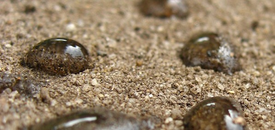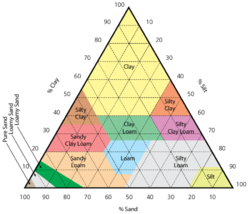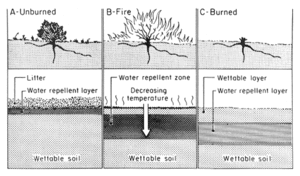Hydrophobic soil

Definition & Entomology
The term “hydrophobic” stems from the Greek prefix- hudōr, ‘water’ and the Latin and Greek suffix- -φοβία, ‘-phobía’. It is biologically defined as tending to repel or mix with water. Hydrophobicity is introduced as a property of soils when waxy, organic substances coat the surface area of soil particles, essentially making the soil impenetrable by any precipitation or other liquids. This water repellent layer is highly variable in effects depending on where the given site is.

Distribution
Hydrophobic soils are expected to be more prevalent in hot, temperate climates[9] in soils predominately composed of Sand (<5% Clay). The increased particulate surface area of sand, sandy loam, and loamy sand soils create the most attraction with organic substrates out of all soil classifications. The insoluble compounds that induce this phenomenon are allocated in the Vegetable Mould and Humus layers of the various Soil Horizons. Water repellent soils have been located in all western and southwestern parts of the United States, Canada, Finland[9], Australia[10], Portugal[5], Columbia[6], Greece[13] and is abundant in many parts of the world. Water repellent soils can be found on all continents excluding Antarctica.
Fertilizer use in both household and large-scale agricultural settings can accidentally induce water-repellency of soil regardless of temporal region. Treatments containing calcium or magnesium hydroxide especially have been shown to mix with the fatty acids of soils, creating insoluble molecules[11].
Effects
Wildfires

Landscapes with hydrophobic soil elements are vulnerable to catching on fire. The soil particles are deprived of water making the soil dense and extremely dry. Soil moisture is one of the most important factors when considering Decomposition of organic matter, so with decreased soil moisture there is respectively less decomposition occurring.
In forested biomes, the huge biomass stock of leaf litter and anthropogenically placed mastification[2] deposits on the forest floor acts as fuel for fire and responds quickly to ignition. Needle leaf trees such as those included in the pine (Pinus), spruce (Picea), and hemlock (Tsuga) genera speed up the hydrophobic process as well when their needles fall and gather on the ground creating buildups of litter. Fire breaking out in these areas causes the wax substrate from all of the collective needles to melt into a relatively thick hydrophobic wax layer below the surface of the soil. A ground surface that had little to no water repellency before a fire will show increased amounts of water repellency post-fire, creating a positive loop between fires and hydrophobicity.
Erosion & Runoff
With the loss of above ground biomass caused by forest fires, stunted growth and development of flora, and the water repellent layer in itself, natural hydrological processes of an ecosystem accelerate. Decreased root biomass and overall decrease in above ground coverage following a forest fire expose the soil to weathering and erosion. Hydrophobic soil layers will stop the infiltration of rainwater causing it to either remain stagnant or flow downstream, depending on the slope of the site. In instances following a wildfire, runoff has been shown to increase up to 4x the normal amount and continues for two vegetation seasons or until the effects of the fire wear off. [8]
The increased erosion and runoff rates can induce flooding and sediment transport to downstream communities and ecosystems, especially in the aftermath of fire[8]. Water repellent soil will cause hydrological processes to occur but fires worsen the effects by removing natural barriers, such as broken tree limbs, which would normally act as speed bumps for runoff precipitation. Runoff flowing through burned areas picks up ash and debris which contain highly soluble nutrients[4], sending them downstream through water channels.
Plant Establishment

Areas where fungal mycelia once dominated will result in hydrophobic, bare patches of soil. The mycelia rapidly stimulate fungal growth, exhausting the soil of its water content. After the sprouts dry and die off, the soil that was beneath them becomes water repellent and inhibits growth of any grasses or plant that was present before they arrived- this was first described as the fairy ring phenomenon[7]. Folklore prior to scientific investigation states that these are the spots where dancing fairies once were, the footpath of dragons, or “where the devil churned his butter”[4].
Water repellency makes it extremely difficult for seeds to germinate and grow. The non-absorbent layer has little water content to offer new seedlings that require optimal levels through germination and initial growth stages. In addition to this, seeds may also be carried off of the site with the hydrophobically induced runoff, severely decreasing the chance of seed and Plant establishment[4]. Smaller seeds and larger slopes result in the highest rate in reduction of soil water availability. The seeds that end up settling into the soil must compete at greater levels with same and differing species for limited nutrients.
Treatment and Sampling

The most commonly documented treatment of hydrophobic soil is done by adding moisturizing clay agents in a process referred to simply as “claying”. Because the most vulnerable soils tend to be sand-based, clay mixtures aid the soil its being added to by allowing water and nutrient retention to occur[1]
To determine if a soil site must undergo treatment, a few things must be determined regarding the sample. The first and most straight-forward method of testing for general hydrophobicity is the Water Drop Penetration Time (WDPT) test- where 1-3 droplets of distilled water are placed directly onto a smooth soil surface and measured for rate of absorption. For general scale, a resulting time of 5 seconds or greater classifies the sample as "hydrophobic". Initial water intake of wettable soil occurs rapidly because of the strong attraction between the water molecules and dry soil aggregates [4]. However, the water infiltration rate of repellent soils is either very slow or non-existent. Therefore, repellent soil will cause naturally occurring precipitation and the experimental water droplet to bead on top of the sample, if or until it is completely absorbed. This test is best performed under dry climatic periods to attain the highest possible hydrophobic qualities that may occur in the field. The values obtained for this experiment are measured by absorption per parameter of time [cm/s] or percentage [%][13].
Determining the textural classification of the soil sample is common for scientific and research purposes. Tools such as sieves and hydrometers are most typically used in Soil Particle Size Analysis Methods to determine what percent sand, silt, and clay are held in the soil. The USDA's Soil textural classification triangle is used to determine the type of soil once the sample is tested for particle ratios.
Sources
1. “ Effects of Organic Compounds, Water Content and Clay on the Water Repellency of a Model Sandy Soil.” Soil Science and Plant Nutrition, vol. 53, no. 6, Dec. 2007. [6]
2. Busse, Matt D., et al. “Lethal Soil Temperatures during Burning of Masticated Forest Residues.” International Journal of Wildland Fire, vol. 14, 2005, pp. 267–276., doi:https://www.fs.fed.us/psw/publications/busse/psw_2005_busse001_ijwf.pdf. [7]
3. Cesarano, Gaspare. “The Influence of Plant Litter on Soil Water Repellency: Insight from 13C NMR Spectroscopy.” PloS One, vol. 11, no. 3, Mar. 2016. [8]
4. DeBano, Leonard F. “Water Repellent Soils: a State-of-the-Art.” United States Department of Agriculture Forest Service Pacific Southwest Forest and Range Experiment Station: General Technical Report PSW-4, Mar. 1981, pp. 4–20. [9]
5. Doerr, S.H., et al. “Soil Water Repellency: Its Causes, Characteristics and Hydro-Geomorphological Significance.” Earth Science Reviews, vol. 51, no. 1-4, Aug. 2000, pp. 33–65. [10]
6. Jurez, Laura Daniela, et al. “Stabilization of Colombian Lateritic Soil with a Hydrophobic Compound (Organosilane).” International Journal of Pavement Research and Technology, vol. 11, no. 6, Nov. 2018, pp. 639–646., apps.webofknowledge.com.gate.lib.buffalo.edu/CitedFullRecord.do product=WOS&colName=WOS&SID=8DQlpZIc13phMJI24Hm&search_mode=CitedFullRecord&isickref=WOS:000087736400012. [11]
7. Nieves-Rivera, Angel M. "The fellowship of the rings: UFO rings versus fairy rings: fungal diseases, mushrooms, fairy rings (a fungus ring), bioluminescent fungi, and slime molds are presented as possible explanations for some UFO rings or 'landing rings.'." Skeptical Inquirer, Nov.-Dec. 2003, p. 50+. Science In Context, http://link.galegroup.com.gate.lib.buffalo.edu/apps/doc/A110575766/SCIC?u=sunybuff_main&sid=SCIC&xid=05479006. Accessed 29 Apr. 2019. [12]
8. Pierson, Frederick B., et al. “Impacts of Fire on Hydrology and Erosion in Steep Mountain Big Sagebrush Communities.” International Journal of Wildland Fire, vol. 11, no. 2, 2003, p. 145. [13]
9. Rasa, Kimmo, et al. “Water Repellency of Clay, Sand and Organic Soils in Finland.” AGRICULTURAL AND FOOD SCIENCE, vol. 16, 2007, pp. 267–277. [14]
10. Robichaud, P.R., et al. “A Probabilistic Approach to Modeling Postfire Erosion after the 2009 Australian Bushfires.” 18th World IMACS / MODSIM Congress, July 2009, pp. 1–7. [15]
11. Wander, I. W. “An Interpretation of the Cause of Water-Repellent Sandy Soils Found in Citrus Groves of Central Florida.” Science, vol. 110, no. 2856, 1949, pp. 299–300., doi:10.1126/science.110.2856.299. [16]
12. White, Carleton S. “Homogenization of the Soil Surface Following Fire in Semiarid Grasslands.” Rangeland Ecology and Management, vol. 64, no. 4, 2011, pp. 414–418. [17]
13. Ziogas, Apostolos K., et al. "Soil water repellency in north-eastern Greece with adverse effects of drying on the persistence." Australian Journal of Soil Research, vol. 43, no. 3, 2005, p. 281+. Science In Context, http://link.galegroup.com.gate.lib.buffalo.edu/apps/doc/A133910175/SCIC?u=sunybuff_main&sid=SCIC&xid=2238eb00. Accessed 25 Apr. 2019. Accessed 25 Apr. 2019.